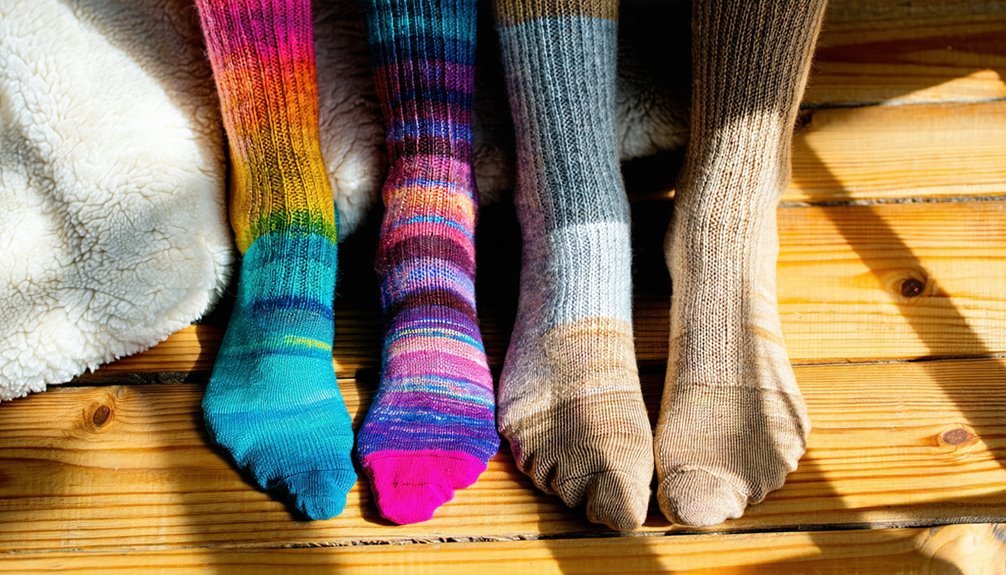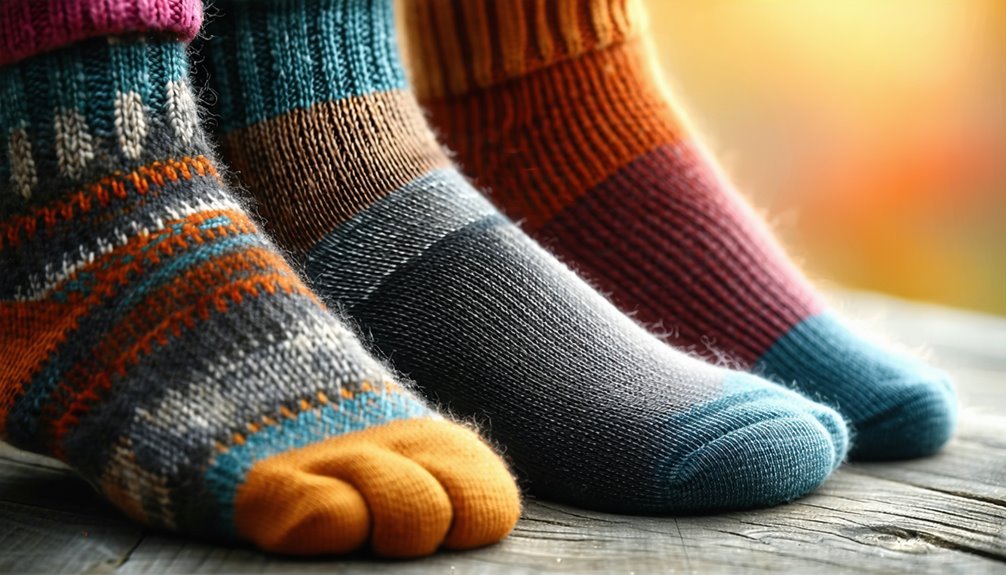Acrylic Vs Wool Socks
When deciding between acrylic and wool socks, consider each material's characteristics. Acrylic, a synthetic polymer, offers durability, elasticity, and quick-drying properties, making it ideal for mild weather and active use. Wool, a natural fiber, provides superior warmth, breathability, and moisture-wicking, perfect for cold climates. Acrylic may retain odors, while wool offers natural odor resistance. Maintenance differs too: acrylic is machine-washable, wool needs delicate care. Explore further insights into their unique fabric properties.
Material Composition and Characteristics

When comparing acrylic and wool socks, it is essential to understand their material composition and characteristics. Acrylic, a synthetic polymer, offers durability and resistance to wear, which translates to longer-lasting socks. Its material benefits include lightweight properties and reduced moisture absorption, making it less prone to harboring bacteria. Wool, a natural fiber, excels in texture comparison with its soft, insulating properties. This organic material provides warmth and comfort, ideal for those prioritizing skin safety and breathability.
From a material benefits perspective, acrylic's texture is smooth and itch-free, suitable for sensitive skin. Wool's texture, while plush, can feel rough to some. Understanding these differences guarantees you select socks that align with your safety needs and comfort preferences, maximizing both protection and tactile satisfaction.
Performance in Various Weather Conditions
Although both acrylic and wool socks have their merits, their performance in various weather conditions markedly differs due to their inherent material properties. Wool socks excel in cold climates thanks to superior insulation properties. Wool fibers trap air, providing a thermal barrier that retains warmth, essential in low-temperature environments. Furthermore, wool's natural breathability factors allow moisture to escape, reducing the risk of dampness and maintaining dry conditions for your feet. Conversely, acrylic socks, while lightweight and quick-drying, lack the robust insulation properties of wool. They perform better in milder conditions where moisture management is a priority over heat retention. Acrylic's synthetic fibers offer moderate breathability, ensuring basic protection without compromising safety in shifting weather. Choose based on specific environmental demands.
Comfort and Fit Considerations
In the domain of comfort and fit, the choice between acrylic and wool socks hinges on the distinct structural properties of each material. Acrylic socks offer higher elasticity levels, ensuring a snug fit that adapts to your foot's shape, but they may compromise breathability factors. Wool socks, renowned for their natural fibers, provide superior breathability, promoting moisture-wicking and reducing the risk of overheating.
Consider these aspects:
- Acrylic: Greater elasticity, enhancing fit security.
- Wool: Enhanced breathability factors, critical for moisture management.
- Acrylic: Synthetic fibers, potentially retaining odors.
- Wool: Natural insulation properties, offering temperature regulation.
- Acrylic: Lightweight construction, facilitating ease of movement.
Ultimately, your choice reflects a balance between desired fit security and breathability, ensuring maximum comfort and safety.
Durability and Maintenance
Despite their differences in material composition, both acrylic and wool socks offer distinct advantages regarding durability and maintenance. Acrylic socks boast high resistance to wear and tear, largely due to their synthetic fiber structure, making them a cost-effective option. They're easy to maintain, requiring simple machine washing, which enhances their sustainability factors by prolonging their lifespan. Wool socks, crafted from natural fibers, offer impressive durability too, particularly when reinforced with nylon or spandex. However, they require more meticulous care, such as hand-washing and air-drying, to maintain their structural integrity.
For safety-conscious users, wool's natural antibacterial properties offer added hygiene, while acrylic's hypoallergenic nature reduces skin irritation risk. In cost comparisons, acrylic socks typically present a lower upfront investment, balancing durability with affordability.
Best Use Cases for Each Material

Choosing the right material for your socks depends on specific use cases that align with the fabric's properties. When considering safety and comfort, acrylic and wool each have distinct advantages. Acrylic socks excel in moisture-wicking and quick-drying, making them ideal for high-intensity activities and aligning with activewear fashion trends. Wool socks, known for thermal regulation and natural cushioning, are perfect for colder climates and align with classic sock styles in outdoor or casual settings. Here's a quick look at the best use cases for each:
- Acrylic: High moisture management
- Acrylic: Quick drying for active lifestyles
- Wool: Superior insulation in cold environments
- Wool: Natural odor resistance
- Acrylic: Conforms to vibrant fashion trends
Evaluate your needs and select the material that guarantees both style and safety.
Frequently Asked Questions
Are Acrylic or Wool Socks More Environmentally Friendly?
When considering sustainability comparison, you'll find wool generally scores higher due to its natural fiber biodegradability. Acrylic, being synthetic, isn't biodegradable, impacting the environment more. Assess each fabric's properties for informed, eco-conscious decisions prioritizing safety and sustainability.
Do Acrylic Socks Cause Allergies or Skin Irritation?
Imagine tiny irritants nudging your skin; that's acrylic's potential. Its synthetic nature might spark discomfort in sensitive folks. While wool sensitivities exist, acrylic irritants can sometimes lead to more frequent issues. Choose wisely for your comfort and safety.
Can Wool Socks Be Worn by People With Wool Sensitivities?
If you've got wool sensitivities, symptoms like itching or rash may occur. Consider wool alternatives like bamboo or synthetic fibers. These materials offer similar properties without triggering reactions, ensuring comfort and safety for sensitive skin.
Are There Any Vegan Alternatives to Wool Socks?
Oh, you're seeking vegan sock alternatives? Consider plant-based materials like bamboo or hemp. They're not just trendy in sustainable fashion; they offer moisture-wicking properties and safety for sensitive skin, ensuring comfort without the woolly guilt.
Which Type of Sock Is More Cost-Effective in the Long Run?
In cost comparison and durability analysis, consider fabric properties. Assess material longevity and maintenance costs. Prioritize safety by evaluating thermal insulation and moisture control. Proper analysis guarantees you're investing in socks that meet your long-term needs efficiently.







